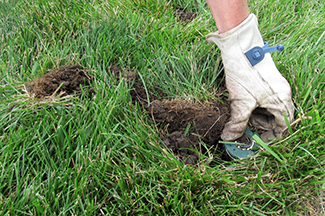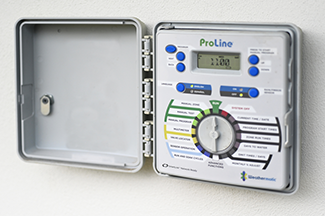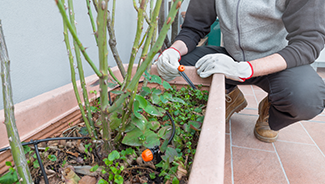Making Sure the Grass Is Always Greener on Your Side of the Fence
How To Make Sure the Grass Is Always Greener on Your Side of the Fence
Automated irrigation systems can make lawn and landscape easy unless the system has been poorly maintained. Broken sprinkler heads, hardware, and clogged lines can cause poor irrigation, over-saturation, and standing water. Neglecting irrigation problems can quickly lead to damaged landscapes, a heaving foundation, higher utility bills, and repair costs.
Keep your irrigation system in good working order by performing routine system checks.
Monthly Maintenance
 AMWUA suggests that the system be checked monthly for leaks, clogged emitters, and other problems.
AMWUA suggests that the system be checked monthly for leaks, clogged emitters, and other problems.
- Turn on the system at least thirty minutes before the inspection to allow enough time for emitter wetting patterns to show.
- Walk through the yard, checking the pipe/poly tubing for leaks, and checking each water distribution endpoint (emitters or micro tubing) to see if it is functioning properly. Because chipmunks find the small tubing tasty, look for tiny gnaw marks and punctures.
- Replace or repair damaged or clogged emitters and micro tubing.
- Check the location of water distribution endpoints. Emitters and micro tubing can be moved as a result of yard maintenance activity (i.e., raking) and pet activity (i.e., digging). Return stray emitters and micro tubing to their proper positions.
- Check the schedule on your irrigation controller. Sometimes power failures and other factors will cause the controller to return to a default schedule. Reset the controller if necessary. If the weather has changed, reprogram the controller to accommodate changing plant water needs.
Yearly Maintenance
 AMWUA also suggests annual maintenance, preferably during the spring.
AMWUA also suggests annual maintenance, preferably during the spring.
- Flush the irrigation lines.
- Start with the cap that is closest to the control valve and work your way toward the end of the system.
- Flush each line for about a minute, until the water runs clear. Remember to close each cap before moving on to the next. Do not allow contaminated water to flow back into the line.
- Check valve boxes to make sure they are clear of debris.
- Clean and inspect the filters.
- Inspect filter screens for holes. Replace as needed.
- Clean the system by opening the end of the filter and turning on the system briefly.
- If there is calcium buildup on the screen, remove it and soak it in a solution of 50 percent water and 50 percent vinegar until the buildup is removed.
- Replace the controller battery.
- A fresh battery will save the programmed information and prevent the controller from reverting to the default program in the event of a power failure.
Digging Deeper
Sprinkler Heads
According to the Arizona Department of Water Resources, older irrigation pop-up heads can waste as much as 30 percent of the water they distribute. Their fine spray can easily be blown away. Invest in new units that will deliver the water in droplets at half of the typical rate of a traditional head and are less likely to be caught by a breeze.
 When sprinkler heads are missing or broken, water won't be evenly distributed across the lawn thus, causing wet spots, dry spots, and runoff. Check all sprinkler heads to ensure they are in the right position and angle. A bump from a lawnmower or foot can distribute more water to one side than the other, also causing uneven watering and dry spots.
When sprinkler heads are missing or broken, water won't be evenly distributed across the lawn thus, causing wet spots, dry spots, and runoff. Check all sprinkler heads to ensure they are in the right position and angle. A bump from a lawnmower or foot can distribute more water to one side than the other, also causing uneven watering and dry spots.
A clogged sprinkler head may result in a rise in water pressure that can cause significant damage throughout the irrigation system. Clogs are typically caused when dirt or other debris becomes lodged within a sprinkler head or other outlet. Look for dry grass or browning plants in areas that are typically well irrigated or standing water beneath a sprinkler are common signs that a clog may be present.
Hardware, Rust & Corrosion
Don't blow a gasket. Literally, don't blow a gasket. Replace gaskets, seals, and valves before they wear out to prevent decreased water flow, or even increased water flow in spots it shouldn't be.
Rust and corrosion may appear on metal parts and components that directly come into contact with moisture. Irrigation systems typically use pipes, fixtures, and other hardware that are specifically designed to resist corrosion, yet rusting hardware is still an issue. Rusty water or reduced performance is a sign the irrigation system is for service and maintenance.
Change & Monitor Control Settings
Different plants have different watering needs depending on the season. They may require much more water during the peak heat of summer than they do in the cooler, wetter months. Change controller settings to adjust to your landscape's needs including the run time of your irrigation system. Be mindful of the monsoon season. If it has been particularly dry, you may need to increase the watering or decrease if it has been a wet season.
When to Hire a Professional
Maintaining an irrigation system can be a difficult undertaking for those who don't know what to look for. Finding, identifying, and repairing broken lines or hardware that may be the root of a problem can be challenging. Make sure all areas are diagnosed and repaired by hiring a professional, licensed, reputable landscaper who has a lot of experience with irrigation systems.
Regular maintenance and tune-ups will keep your landscape the envy of your neighborhood, plus, it will also prevent water waste.
Home Maintenance To-Do | #Irrigation | #GardenWater
Podcast
Look at your landscape of trees, flowers and gardens as a whole system. Farmer Greg of the Urban Farm discusses sources of water and mulching up the soil to retain water longer. Components of creating healthy soil. Advantages of shade and ground cover. The challenges and most effective ways to water trees and gardens. And understanding watering zones for a rounded way to water.
###
Photo Credits:
- Shutterstock
RELATED CONTENT:
- Blog: Irrigation: The Backbone Of A Healthy Landscape
- DIY FAQ: Tips To Decrease Your Household Water Consumption
- DIY FAQ: Creating A Lush Landscape Without Excessive Water Usage
- DIY FAQ: What Are The Do's And Don'ts Of A Drip Irrigation System?
- DIY FAQ: How Rainwater Can Be Saved and Used
- DIY FAQ: What Is Xeriscaping?
- DIY FAQ: How Can I Tell If My Landscaping Plants Are A Low Water Variety?
- Podcast: Irrigation: The Backbone Of A Healthy Landscape
- Resource: Landscape Watering
- Resource: Guidelines for Landscape Drip Irrigation Systems
